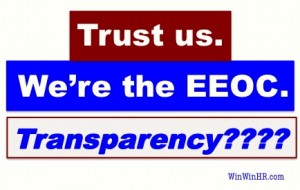 On January 13, 2015, the United States Supreme Court heard oral arguments in which the Equal Employment Opportunity Commission (“EEOC”) made arguments that fly in the face of President Obama’s call for transparency and open government.
On January 13, 2015, the United States Supreme Court heard oral arguments in which the Equal Employment Opportunity Commission (“EEOC”) made arguments that fly in the face of President Obama’s call for transparency and open government.
In the case, Mach Mining v. Equal Employment Opportunity Commission, the EEOC acknowledged its statutory duty to “attempt to resolve” complaints where “reasonable cause” has been found “by informal methods of conference, conciliation and persuasion,” but argued that the EEOC’s compliance with this duty is not subject to judicial scrutiny.
Essentially, the EEOC seemed to be arguing
Trust us. We’re the government. We’re here to help.
Not surprisingly, that argument was not persuasive to several of the justices. Chief Justice Roberts, for example, commented during the oral argument that, “I am very troubled by the idea that the government can do something and we can’t even look at whether they’ve complied with the law.”
The issue of whether the EEOC’s conciliation efforts are subject to judicial scrutiny has been percolating in the lower courts for years. It seems safe to say that private employers and the government have spent millions of dollars debating this issue. In several cases, the EEOC has been sanctioned for failing to comply with its duty to conciliate.
The defense bar argues that the EEOC, at times, abuses its authority by failing to engage in good faith efforts to conciliate before filing lawsuits against employers and that only judicial scrutiny can serve as a check to this abuse of power. The EEOC argues that its duty to conciliate is one of agency discretion entrusted to it by Congress and that there is not a specific conciliation process in place and, as such, its conciliation efforts should not be subject judicial scrutiny.
What is the EEOC hiding? Why is it afraid to put its conciliation process up for review?
As Justice Scalia commented during oral argument, the remedy for the lack of standards is in the EEOC’s hands:
But the remedy for that is is at your hands. As the other side said, you could issue rules which say, this is an informal process, but what it consists of is, number one, we give you notice of what the -what the offense is; we sit down with you to discuss settlement of that; number three, we make apparent to you what our offer is for settling the matter, and whatever other rudiments of conciliation the agency believes in.
What’s wrong with that?
Indeed, what is wrong with us requiring that our governmental agencies be open and transparent in their operating processes?
The government offered three reasons for its failure to issue the regulations – all of which fall flat, especially in light of President Obama’s Open Government Directive:
- the EEOC “needs flexibility in these processes;”
- the EEOC has “its own training procedures about good ways to do conciliation and the steps to be taken;” and
- to issue such regulations assumes that there would be some type of judicial review of whether the EEOC complied with the regulations.
It is Time for Transparency of Process.
I say it is time to stop the debate and for the leadership at the EEOC to step up and lead. It is time for the agency to comply with President Obama’s open government directive. For the EEOC to continue to refuse to issue these much-needed regulations is a flagrant violation of Obama’s call for transparency and open government. It is also simply poor leadership.
Call to EEOC to Start Rulemaking Process
In March of 2013, I presented written testimony to the EEOC urging it to implement a pilot program incorporating a structured ADR process into the EEOC’s post-cause conciliation process. At the time, I suggested that implementing such a program would assist the EEOC in recognizing “the need to conserve its limited economic resources while at the same time staying focused on continuing its mission to stop and remedy unlawful employment discrimination so that the nation can achieve our ultimate vision of justice and equality in the workplace.”
I still think that incorporating a structured ADR process into the EEOC’s post-cause conciliation process would benefit both the agency and assist it in better meeting its mission.
Regardless, however, of the specifics of any conciliation process, the current refusal of the EEOC to issue standards must not continue.
I call on the leaders at the EEOC to comply with the “Open Government Directive” issued on December 8, 2009. To do so, the EEOC needs to take “specific actions to implement the principles of transparency, participation collaboration” as regards the process that the EEOC will follow in complying with its obligation to resolve complaints through informal efforts of conference, conciliation and persuasion.

Great column, Lorene. I agree with everything you said.
Hi Atty Lorene,
How would the EEOC determined which cases should be litigated or not, if according to the agency (EEOC) complaint was true and there was a violation after the agency’s investigation? When the CP is abandoned and becomes “you are on your own”, is like the cops let the criminal go and left the victim(s) hanging. What should one or will do, if one becomes a victim?